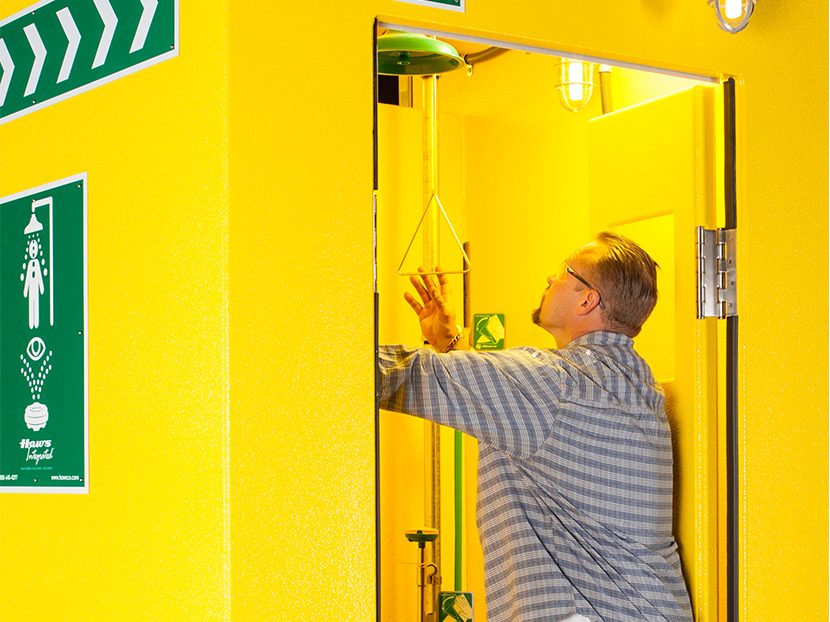Redefining Tepid
Top 5 reasons to provide the right temperature water to eyewashes and showers.








When it comes to emergency shower and eyewash equipment, a 10-degree difference could make all the difference. The right water temperature is critical to ensuring medically suitable results for an injured person. Current ANSI Standards are referenced by the OSHA when evaluating facilities and mandate a temperature range defined as “tepid.” This is clarified as a 40-degree temperature range for flushing fluids spanning from 60 F to 100 F [16 C to 38 C].
Why you need to provide the right water temperature to users
(1) Victim Comfort: According the ANSI Z358.1-2014, 15 minutes is the required length of a drench cycle when using emergency shower and eyewash equipment. It’s a necessary amount of time to ensure the chemicals and contaminants are properly flushed out of the eyes and off the face and body. But water that is too hot or too cold can drive an injured user out of the emergency equipment much too soon, while also risking exposure to additional injury. Providing tepid water to a user helps cool chemical burns, prevents chemical absorption, and encourages the removal of contaminated clothing that can act as a barrier.
(2) Scalding: The body’s biological response to hot water is for its pores to open, which could potentially increase absorption of contaminants into the skin. Plus, water that is too hot can scald the soft tissue of the eyes and delicate skin causing further damage. Less often addressed are chemicals that can trigger an aggravated chemical reaction when it comes into contact with water at particularly higher temperatures.
Caveat: Review SDS (Safety Data Sheet) of chemicals that could become more of a hazard by reacting violently to warmer temperatures. These types of chemicals require setting the water temperature to a specific degree to prevent chemical reactions.
(3) Hypothermia: Water that is too cold can lead to hypothermia on top of the original chemical exposure. Studies have also shown that a 15-minute exposure to water temperatures in the lower end of the ANSI-mandated temperature range (60 F) can cause cold shock. This is the reaction that the body has upon exposure to cold water, and potential side effects including cardiac arrest. Water at low temperatures is also far more likely to prevent an injured worker from drenching for a decontamination period that would prove medically effective. In addition, some severely hazardous chemicals will not dilute to safe levels unless a longer flush is administered such as strong alkali’s that suggest a 60-minute flush.
(4) Bacterial Growth/Legionella: Certain water temperature ranges are more prone to bacterial growth, which can present serious health risks to those exposed. Legionella bacteria growth thrives between 95 F and 115 F, a range that overlaps the current ANSI tepid water range. While the ANSI standard does require a weekly flush to clear all piping sections that lead to the emergency shower and eyewash station, avoiding temperatures that harbor bacteria is a valuable step in limiting potential exposure.
(5) Dated Standards: In 1998, the ANSI Standard introduced tepid water as a requirement of emergency shower and eyewash systems. In the 2004 revision, the standard was further clarified, stating that medical recommendations warned against flushing fluids exceeding 100 F, which “have proven to be harmful to the eyes and can enhance chemical interaction with the eyes and skin” (ANSI Z358.1-2004). The standard also stated that “recent information indicates that a temperature of 60 F is suitable for the lower parameter for tepid flushing fluid without causing hypothermia to the equipment user.” However, no source information accompanied these statements.
This standard was maintained in the 2014 revision, but more insight into both the biological response to water temperatures at the low end of this temperature range and the ideal growth temperature of legionella bacteria should dictate a change.
Recommendations
Each piece of emergency equipment must be available to provide proper first aid in the event of an emergency, and a revised water temperature range between 70 F and 95 F can help ensure medically effective results:
Increasing the minimum flushing fluid temperature to 70 F will:
- Help encourage users to use the equipment for the full 15-minute flush cycle;
- Protect against cold shock that could lead to cardiac arrest; and
- Advocate for the removal of contaminated clothing.
Decreasing the maximum temperature to 95 F will:
- Avoid temperatures known to harbor specific bacteria growth;
- Prevent scalding of the eyes and skin; and
- Reduce the chances of an increased chemical reaction.
A majority of outdoor or extreme climate equipment installations would require additional infrastructure to meet the tepid water range for water delivery. Emergency shower and eyewash manufacturers offer various tempering solutions including thermostatic mixing valves.
Setting thermostatic mixing valve temperatures between 80 F and 85 F not only meets current ANSI Standards, but also ensures compliance should future revisions take into account these recommendations.
Studies show that when proper first aid is provided, an average of 7.7 days of hospitalization were necessary, whereas those who did not receive proper first aid required an average of 20.5 days of hospitalization. Emergency shower and eyewash systems are designed for emergency scenarios, but simply providing them isn’t enough. The equipment needs to perform in accordance with the most current ANSI Z358.1 Standard and work as intended at any time, while providing a comfortable and appropriate temperature water delivery.




